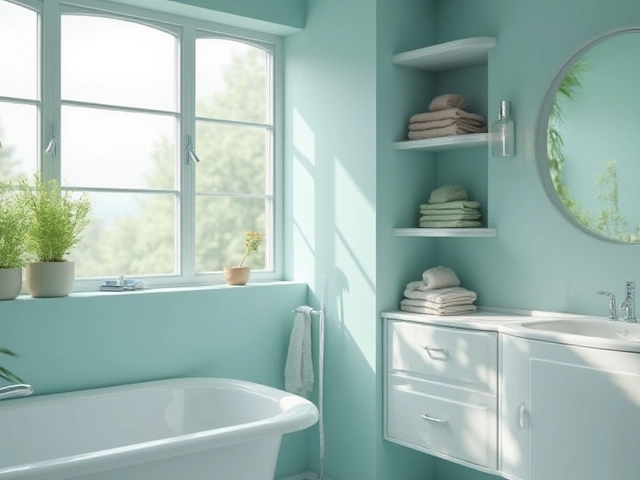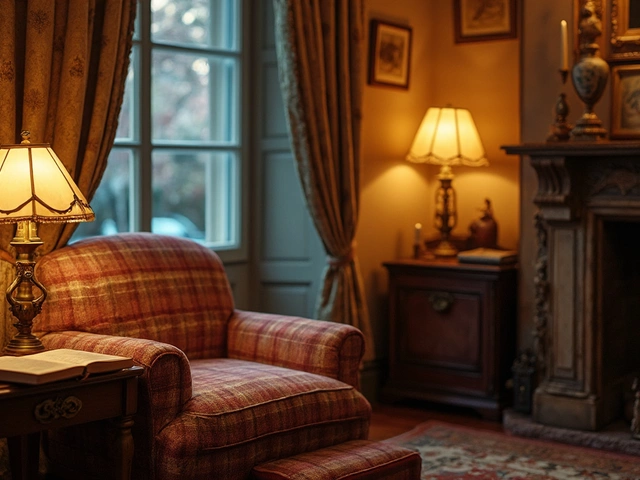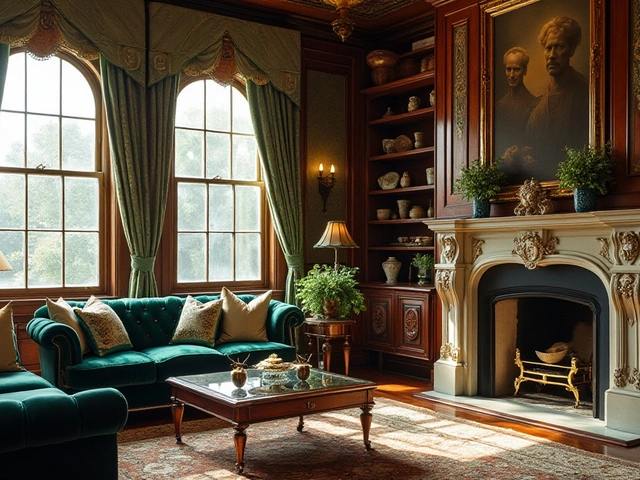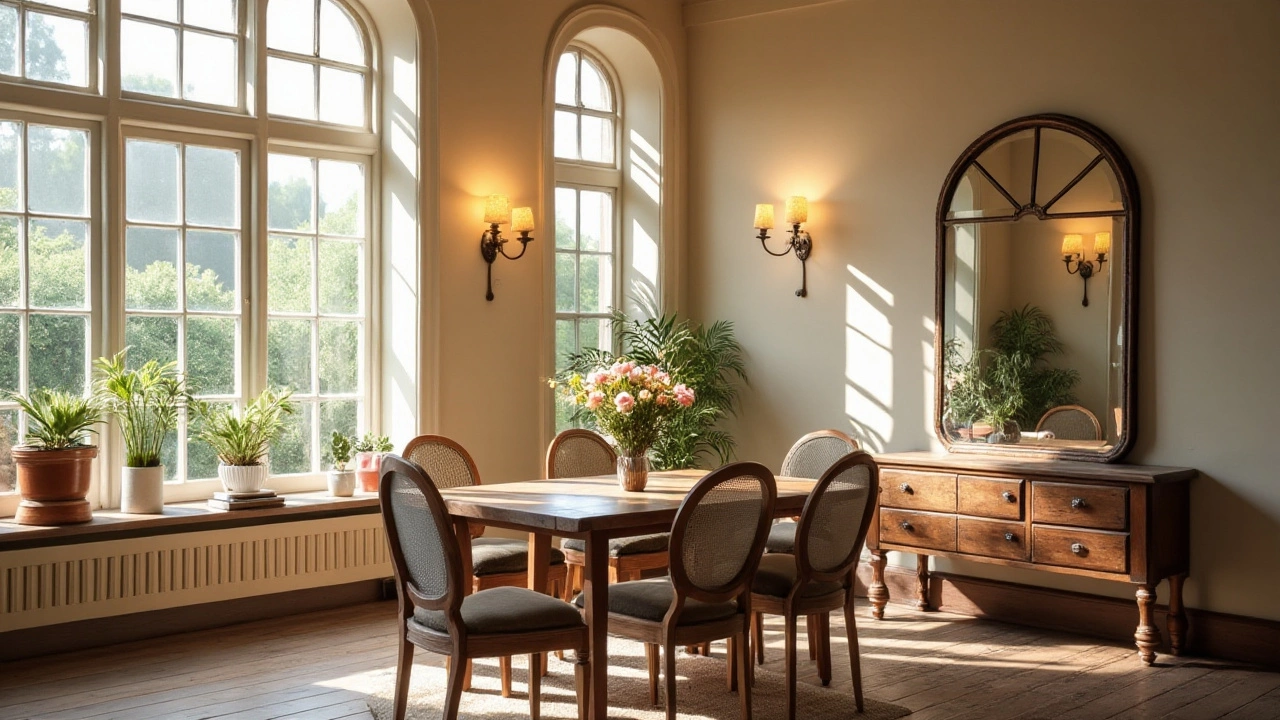
In a dining room, lighting plays a vital role in setting the mood and highlighting the features of the space. The right lighting can turn an ordinary dinner into an extraordinary dining experience. Whether you're hosting a family meal or throwing a lively dinner party, ensuring your dining room is properly illuminated is key.
Natural light serves as the foundation, offering warmth and openness. But as the sun dips and dinner stretches into the night, artificial lighting steps in to take charge. Choosing the right fixtures not only enhances visibility but adds personality to the room. We’ll explore how various elements like mirrors and colors work hand-in-hand with lights to make the dining room shine.
It’s time to make your dining area the brightest and most inviting spot in your home. Let’s explore how to illuminate it with style and grace.
- Maximizing Natural Light
- Choosing the Right Fixtures
- Enhancing with Mirrors and Reflective Surfaces
- Incorporating Layered Lighting
- The Magic of Colors and Textures
Maximizing Natural Light
Sunshine pouring into your dining room can transform the space, enhancing both the visual and emotional atmosphere. Allowing natural light to flow freely is akin to inviting nature inside, giving your dining room a new vibrant energy. Start by assessing your windows. Consider replacing heavy, dark curtains with lighter materials that diffuse sunlight gently throughout the room. Sheer fabrics allow plenty of light while offering some privacy. Also, consider using blinds that can easily be adjusted to control the amount of light according to the time of day. If your dining area is blessed with a generous view, opting for a minimalist window treatment is often the best approach.
If possible, expanding window size can significantly increase the amount of natural light that enters a room. This might mean increasing window height or opting for floor-to-ceiling designs. For those fortunate enough to be designing a dining space from scratch, consider skylights or transom windows to flood the room with additional daylight. Position your dining table to make the most of available light, bringing a spotlight to both meals and conversations. It's crucial to maintain windows clean and free from obstructions, as dirt and objects can block precious daylight and diminish its effect.
Mirrors are marvelous allies in maximizing natural light. By strategically placing mirrors opposite or adjacent to windows, you can reflect light around the room, effectively doubling its presence and impacting even the dullest corners. Choosing large, decorative mirrors can serve both an aesthetic and practical function. «Natural light is the best complement to any design choice you make,» says Emma Baxter, a well-regarded lighting expert.
"Natural light not only enhances the inherent beauty of a space but also plays a major role in improving mood and focus," she explains.
Among practical strategies, a fresh coat of paint in a lighter hue can do wonders. Lighter wall colors reflect more light, giving the perception of a brighter, airier space. Consider soft whites, gentle greys, or even pastels to achieve this effect. If your dining room is dedicated to a warm, rustic vibe, you might want to try light beige or sand tones complemented by natural wood finishes to still capitalize on natural light with a cozy feel. On darker days or in less naturally blessed rooms, leveraging various interior design techniques can amplify what light does manage to come in. Use furniture with reflective surfaces or light-colored upholstery to continue to diffuse light.
For the gardening enthusiasts, houseplants placed near windows can filter and play with light shadows beautifully. Not only do plants give a fresh and lively look, but they also have been known to boost mood and air quality. Consider small yet sturdy plants like succulents or ferns, which thrive in bright locations. Remember to rotate plants regularly so all sides have their fill of sunlight.
Data supports that well-lit environments are linked to increased happiness and productivity. According to a study published in the Journal of Clinical Sleep Medicine, exposure to natural light improves mood, enhances sleep, and even supports concentration levels during the day. Making the most of natural light is not just a design choice; it’s a lifestyle improvement that benefits the occupants significantly.
Choosing the Right Fixtures
Choosing the right fixtures for your dining room is more than just a shopping endeavor; it's a chance to enhance both functionality and artistry in your space. The right dining room lighting can set the mood, inspire conversation, and even make your meals look more appetizing. First, consider the primary function of the room. If your dining area is multi-purpose—serving as a workspace or a place for nightly homework sessions—you might need adjustable lighting solutions. Pendant lights are popular choices, known for their versatility and ability to make a bold design statement. Available in myriad styles and materials, they can either seamlessly blend with your dining decor or stand out as a focal piece.
When sizing a light fixture, the rule of thumb is that the diameter of the pendant should be about one-half to two-thirds the width of the dining table. This ensures balanced proportions in the room. Overly large fixtures can overwhelm the space, while too-small fixtures might get lost in the backdrop. If you have an oblong or rectangular table, consider using a series of pendants or a linear suspension light to provide consistent illumination down the length of the table.
Chandeliers remain a classic choice for dining rooms, boasting timeless elegance that can fit both traditional and modern interiors. Look for designs that reflect your personal style—be it crystal-laden for a touch of glamour or a minimalist metal frame for a modern edge. According to House Beautiful, “Layering is key in lighting design. Combine different sources of light at different heights to make a dining room feel lively and dynamic.” Consider complementing a chandelier with wall sconces or ambient lighting to create depth and mood.
For those seeking more sustainable options, LED technology offers myriad benefits. LEDs consume less energy and have longer lifespans than traditional bulbs, reducing both electric bills and environmental impact. They also come in various color temperatures, allowing you to choose warm or cool tones to suit your dining room's atmosphere. Advances in smart lighting mean that LED fixtures can be integrated with home automation systems, letting you dim the lights or change colors with ease via smartphone apps.
Functionality doesn't mean sacrificing style. For instance, if you enjoy a contemporary aesthetic, opt for fixtures with sleek geometric designs or mixed materials such as wood and metal. Rustic styles often play with organic shapes and aged finishes. The blend of different materials and shapes adds character and creates a dynamic visual interest, drawing eyes upward and enhancing the room's appeal. At the heart of any dining room transformation is a light fixture that tells its own story—illuminating not just your table, but your creativity too.
Here's a quick checklist to guide your fixture selection process:
- Determine the primary function of your dining area.
- Choose fixtures that complement your table size and room proportions.
- Explore different styles that align with your personal and overall home decor.
- Consider energy-efficient LED technology for sustainability.
- Layer lighting with a mix of overhead lighting, wall fixtures, and floor lamps for ambiance.
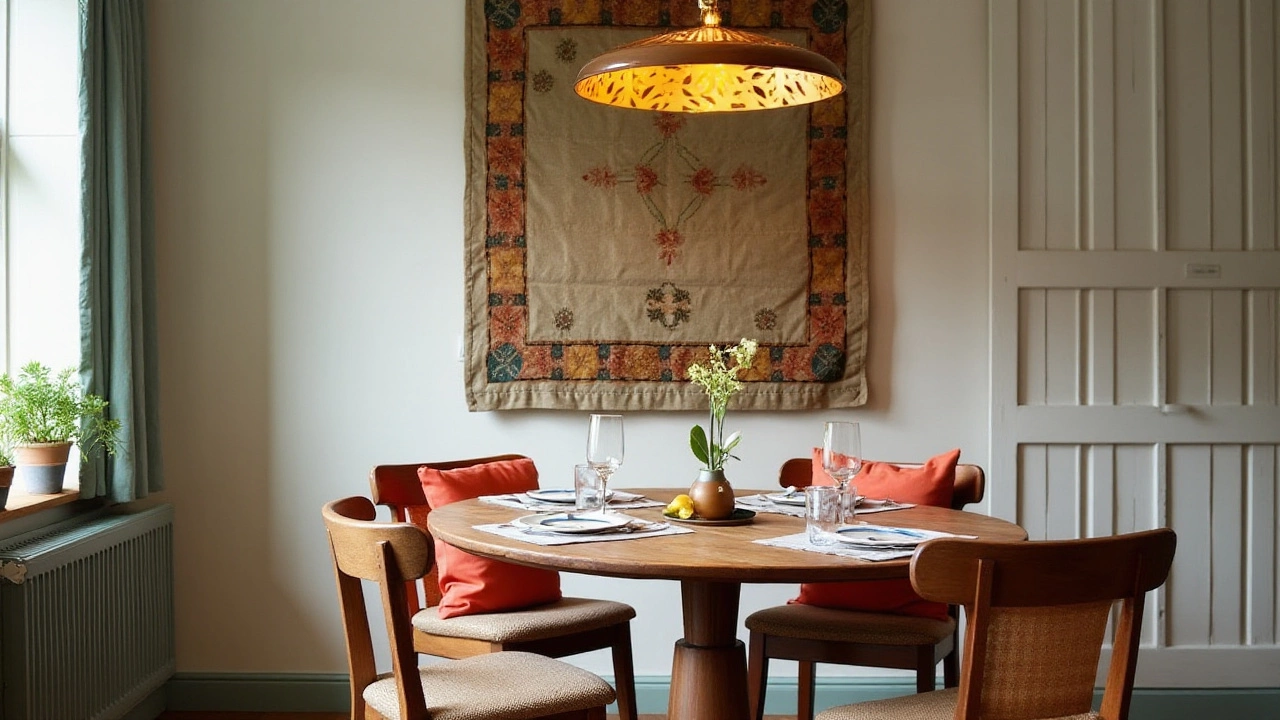
Enhancing with Mirrors and Reflective Surfaces
When it comes to transforming a dining room into a radiant space, few tools are as effective as mirrors and reflective surfaces. These elements have the impressive ability to bounce light around a room, amplifying brightness in visually enticing ways. The strategic placement of mirrors shouldn't be overlooked if you're aiming to increase illumination without an extensive overhaul of lighting fixtures. A simple mirror can make a small dining area feel expansive and inviting, reflecting natural and artificial light alike to create a sense of airy spaciousness.
Mirrors can be placed in various locations for different effects. For example, placing a large mirror opposite a window directs sunlight across the room during the day, maximizing the natural light you already have. Similarly, mirrors positioned opposite a piece of artwork or a striking light fixture can add depth and dimension, drawing eyes across the space to appreciate these features from multiple angles.
When selecting mirrors for your dining room, think about both size and style. While oversized mirrors can make a bold statement, smaller, intricately-framed mirrors can add charm and sophistication. The frames themselves provide additional opportunities to complement the room's aesthetic—be it contemporary, rustic, or somewhere in between. Incorporating materials such as metal or wood in the frames can offer texture and contrast, further enhancing the room’s overall decor.
As renowned interior designer Kelly Hoppen explains, "Mirrors and reflective materials capture the spirit of a space, magnifying its presence while delicately multiplying light sources."
Reflective surfaces go beyond mirrors alone. Consider using glossy furniture finishes, metallic accessories, or glass elements to enhance illumination. Dining tables with a glass top, for example, not only add a touch of elegance but reflect overhead chandeliers, casting a soft glow throughout the space. Metallic candlesticks or vases can also bounce light, creating dancing highlights as you move around the room.
Using reflective surfaces smartly while layering them with various textures prevents the space from feeling sterile or overly polished. It provides a harmonious balance that maintains intimacy while ensuring vibrance, making your dining room not only a place for meals but an expression of well-considered interior design. With thoughtful execution, mirrors and reflective items can transform your dining room into a brilliantly lit masterpiece without requiring extra wiring or installation.
Incorporating Layered Lighting
Layered lighting is an essential strategy when it comes to creating a *dining room lighting* scheme that is both functional and visually appealing. This approach combines various types of light sources, tailored to fit a dining room’s unique needs. The idea of layered lighting is to create a balance between different lighting layers such as ambient, task, and accent lighting which work together to produce a cohesive and inviting glow. Incorporating these different layers not only highlights the architectural details and furniture in your space but also allows control over the atmosphere based on different occasions.
Let's start with ambient lighting, which serves as the main source of light, akin to a room's 'natural' light. Often achieved through ceiling fixtures such as chandeliers or pendant lights, ambient light casts general illumination and ensures your dining space is evenly lit. The trick is to choose fixtures that complement your dining room's style - be it a classic crystal chandelier for a traditional space or sleek metallic pendants for a modern touch.
Task lighting, the second layer, is designed to support specific activities like dining, reading a menu, or even laying out a board game after dinner. Often positioned directly above the dining table, these lights can take the form of a dimmable pendant or recessed lights, allowing you to control the light’s intensity as needed. Imagine a thoughtfully designed setup where recessed downlights frame the table, casting just the right amount of focus.
Accent lighting is where creativity comes into play. This layer is all about drama and can be used to draw attention to specific features of the room such as artwork, an elegant sideboard, or architectural details like a stone feature wall. Wall sconces, uplighting, or even LED strips installed beneath furniture can serve this purpose—adding depth and interest to the space.
Interestingly, a study from the American Lighting Association states that rooms designed with layered lighting boost occupant mood and productivity by up to 30%.
"Lighting isn't just about visibility. It's about creating an environment where you feel your best," suggests renowned interior designer Nate Berkus.
Consider an intelligent lighting control system; this could allow you to adjust the layers of your lighting with ease, perhaps even with a schedule or remotely via your smartphone. Such systems can additionally support energy efficiency, tailoring light usage to your presence and needs. In laying out your own layered lighting scheme, remember it's more than combining lights. It's about orchestrating them to to brighten your dining experiences.
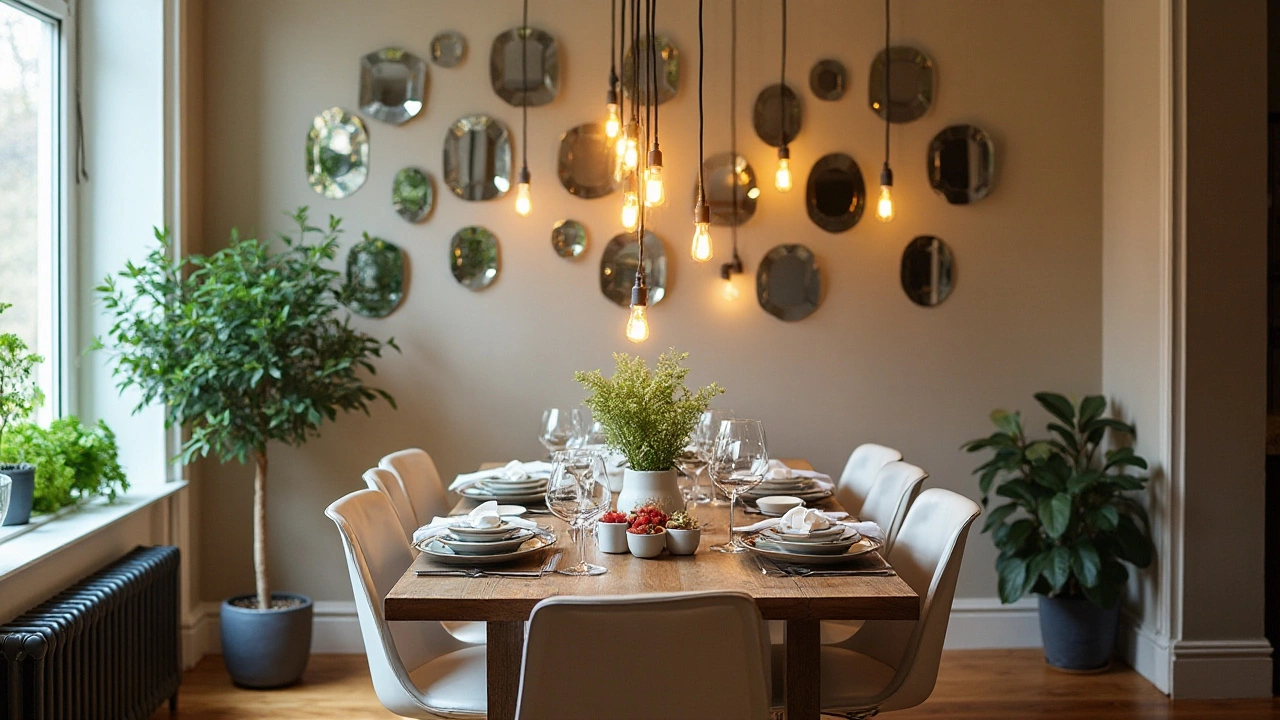
The Magic of Colors and Textures
When considering the aesthetics of a dining room, the interplay of colors and textures often works silently yet powerfully to create a captivating environment. Colors have the ability to reflect light, influence mood, and make a space feel larger or cozier, depending on the choice and application. For instance, lighter shades such as soft blues, creamy whites, or gentle pastels can bounce light around the room, making an area feel airier and more expansive. On the contrary, rich tones like deep reds or warm browns can add a sense of intimacy and warmth, perfect for a cozy dining setting.
Textures play just as crucial a role as colors in enhancing the dining experience. The tactile element of different surfaces contributes to the ambiance and overall feel of the space. Consider incorporating a mix of textures through fabrics, wall coverings, and even the dining table accessories. A wooden table provides an organic and warm touch, while metallic elements such as brass or chrome can introduce a modern and sleek vibe to your space. Textured walls or textiles, like woven placemats or a patterned rug, bring in visual interest that complements the lighting beautifully.
Combining colors and textures requires a thoughtful approach to ensure harmony and balance in the dining space. It's not just about what you see, but also what you feel. According to a study by the American Lighting Association, a harmonious blend of well-chosen colors and textures can transform an ordinary dining room into a sensory delight, elevating not just the décor but also the dining experience itself.
"Good lighting paired with a well-thought-choice of colors sets the perfect stage for creating memorable meals," shares renowned interior designer, Emma Willis.
Experimentation can be rewarding here. Try pairing bold colored chairs with a neutral table, or adding textured cushions or throws to introduce some pattern and depth without overwhelming the space. Lighting up a statement wall with strategically placed dining room lighting fixtures can accentuate your favorite colors and textures, bringing the room’s design to life. Don’t shy away from using natural elements like plant foliage or floral arrangements to add an additional layer of texture and color, which can dynamically respond to lighting changes.
In many ways, enhancing a dining area with the right colors and textures is like crafting a fine painting, where every brushstroke and hue contributes to the masterpiece. This combination not only complements your interior design theme but also speaks to your personal style and the unique ambiance you wish to create. Whether your aim is to craft a tranquil nook or an elegant setting for lively gatherings, embracing the magic of colors and textures will undoubtedly light up your dining room experience.


